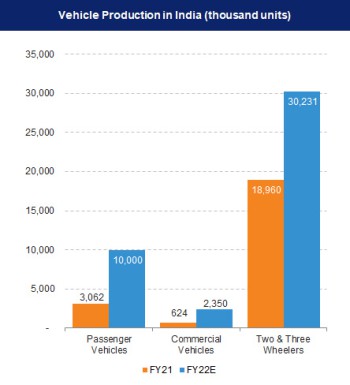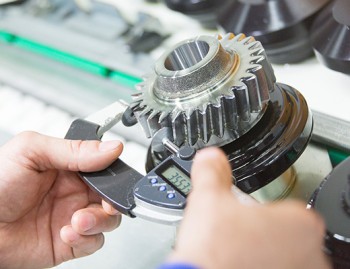INTRODUCTION
The Indian auto-components industry has experienced healthy growth over the last few years. The auto-components industry expanded by a CAGR of 3.28% over FY16 to FY20 to reach US$ 45.90 billion in FY21. The industry is expected to reach US$ 200 billion by FY26.
Due to high development prospects in all segments of the vehicle industry, the auto component sector is expected to rise by double digits in FY22.
Auto-components industry accounts for 7.1% of India’s Gross Domestic Product (GDP) and employs as many as 5 million people directly and indirectly. A stable government framework, increased purchasing power, large domestic market, and an ever-increasing development in infrastructure have made India a favourable destination for investment.
MARKET SIZE
The industry can be broadly classified into organised and unorganised sectors. The organised sector caters to original equipment manufacturers (OEMs) and consist of high-value precision instruments while the unorganised sector comprises low-valued products and caters mostly to the aftermarket category.
The automobile component industry turnover stood at Rs. 1.96 lakh crore (US$ 26.6 billion) between April–September 2021 and is expected to witness revenue growth of 15-17% during the fiscal year. In first half of FY22, exports of auto components grew by 76% to Rs. 68,746 crore (US$ 9.3 billion). As per the Automobile Component Manufacturers Association (ACMA) forecast, automobile component exports from India are expected to reach US$ 80 billion by 2026. The Indian auto components industry is expected to reach US$ 200 billion in revenue by 2026.
Strong international demand and resurgence in the local original equipment and aftermarket segments are predicted to help the Indian auto component industry grow by 20-23% in FY22.
INVESTMENTS
To keep up with the growing demand, several auto makers have started investing heavily in various segments of the industry during the last few months. The industry attracted Foreign Direct Investment equity inflow (FDI) worth US$ 30.78 billion between April 2000-September 2021, accounting for 5.49% of the total equity FDI during the period.
Some of the recent/planned investments and developments in the automobile sector in India are as follows:
- In February 2022, a memorandum of understanding (MoU) was signed between electric two-wheeler company Ather Energy and Electric Supply Companies (ESCOMs) of Karnataka for setting up 1,000 fast charging stations across the state.
- In February 2022, Tata Power and Apollo Tyres Ltd announced a strategic partnership for the establishment of 150 public charging stations across India.
- In January 2021, leading commercial vehicle manufacturer Ashok Leyland teamed up with Aidrivers, a global leader in AI-enabled autonomous solutions for industrial mobility, to develop AI-enabled autonomous vehicles to fulfil the demands of a sustainable future.
- Two-wheeler EV maker HOP Electric Mobility, a diversified business venture of Rays Power Infra, is looking at investing Rs. 100 crore (US$ 13.24 million) over the next two years to expand manufacturing capacity for its EVs.
- In December 2021, TVS Motor Company and BMW Motorrad, announced a partnership in the two-wheeler EV space, with plans to release their first electric two-wheeler within the next two years.
- In December 2021, Hyundai announced plans to invest Rs, 4,000 crores (US$ 530.25 million) in R&D in India, with the goal of launching six EVs by 2028.
- In November 2021, Indian Oil Corporation (IOC) and two other public sector oil firms announced that they will install 22,000 EV charging stations in India over the next 3–5 years.
- In November 2021, Skoda Auto announced plans to locally manufacture electric cars in India. However, the firm may bring its first EV, the Enyaq, through the CBU route, before committing to local manufacturing.
- In November 2021, Hero Motor (HMC), the parent company of Hero Cycles, entered a joint venture partnership with Yamaha, a Japanese two-wheeler major, to make electric motors for e-bicycles for the global market.
- In October 2021, Tata Motors announced that private equity group TPG along with ADQ of Abu Dhabi has agreed to invest Rs. 7,500 crore (US$ 1 billion) in its EV division.
- A cumulative investment of Rs. 12.5 trillion (US$ 180 billion) in vehicle production and charging infrastructure would be required until 2030 to meet India’s EV ambitions
GOVERNMENT INITIATIVES
The Government of India’s Automotive Mission Plan (AMP) 2006-2026 has come a long way in ensuring growth for the sector. Indian Automobile industry is expected to achieve a turnover of US$ 300 billion by 2026 and will grow at a CAGR of 15% from its current revenue of US$ 74 billion.
In November 2020, the Union Cabinet approved PLI scheme in automobile and auto components with an approved financial outlay over a five-year period of Rs. 57,042 crore (US$ 8.1 billion). In September 2021, the Indian government issued notification regarding a PLI scheme for automobile and auto components worth Rs. 25,938 crore (US$ 3.49 billion). In February 2022, the government has received investment proposals worth Rs. 45,016 crore (US$ 6.04 billion) from 20 automotive companies under the PLI Auto scheme. This scheme is expected to create an incremental output of Rs. 2,31,500 crore (US$ 31.08 billion).
Government has come out with Automotive Mission Plan (AMP) 2016-26 which will help the automotive industry to grow and will benefit Indian economy in the following ways: -
- Contribution of auto industry in the country’s GDP will rise to over 12%.
- Around 65 million incremental number of direct and indirect jobs will be created.
- End of life Policy will be implemented for old vehicles.

ACHIEVEMENTS
Following are Government’s achievements in the past four years:
- Production of two wheelers, passenger vehicles, commercial vehicles and three wheelers reached 18.34 million, 3.06 million, 0.62 million, and 0.61 million, respectively, in FY21.
- FAME - India Scheme formulated by Department of Heavy Industry, led to a continuous increase in registered OEMs and vehicle models. Also, the scheme enhanced the sales of EVs and about 261,507 electric/hybrid vehicles were supported under the scheme up to December 6, 2018. In February 2019, the Government approved FAME-II scheme with a fund requirement of Rs. 10,000 crore (US$ 1.39 billion) for FY20-22.
- Under National Automotive Testing and research and development (R&D) Infrastructure Project (NATRiP), various facilities including passive safety labs comprising of crash core facility and crash instrumentations including dummies were established at ICAT-Manesar and ARAI-Pune.
- To give a fresh thrust to E-mobility in public transport, Department of Heavy Industry announced the launch of public and shared mobility based on electric powertrain.
ACHIEVEMENTS
The rapidly globalising world is opening newer opportunities for the transportation industry, especially while it makes a shift towards electric, electronic and hybrid cars, which are deemed more efficient, safe, and reliable mode of transportation. Over the next decade, this will lead to newer verticals and opportunities for auto-component manufacturers, who would need to adapt change via systematic R&D.
As per ACMA forecasts, automobile component export from India is expected to reach US$ 80 billion by 2026. With shift in global supply chains, the Indian global automotive component trade is likely to expand at ~4-5% by 2026.
In December 2020, Power PSU JV EESL announced plan to install ~500 electric vehicle (EV) charging stations in the country in fiscal 2020-21. As of March 2021, there were 1,800 charging stations and this is expected to reach 4 lakh by 2026.
The Indian auto-components industry is set to become the third largest in the world by 2025. Indian auto-component makers are well positioned to benefit from the globalisation of the sector as export potential could be increased by up to US$ 30 billion by 2021E.
- Production of two wheelers, passenger vehicles, commercial vehicles and three wheelers reached 18.34 million, 3.06 million, 0.62 million, and 0.61 million, respectively, in FY21.
- FAME - India Scheme formulated by Department of Heavy Industry, led to a continuous increase in registered OEMs and vehicle models. Also, the scheme enhanced the sales of EVs and about 261,507 electric/hybrid vehicles were supported under the scheme up to December 6, 2018. In February 2019, the Government approved FAME-II scheme with a fund requirement of Rs. 10,000 crore (US$ 1.39 billion) for FY20-22.
- Under National Automotive Testing and research and development (R&D) Infrastructure Project (NATRiP), various facilities including passive safety labs comprising of crash core facility and crash instrumentations including dummies were established at ICAT-Manesar and ARAI-Pune.
- To give a fresh thrust to E-mobility in public transport, Department of Heavy Industry announced the launch of public and shared mobility based on electric powertrain.

References: International Organization of Motor Vehicle Manufacturers, Media Reports, Press Releases, Department for Promotion of Industry and Internal Trade (DPIIT), Automotive Component Manufacturers Association of India (ACMA), Society of Indian Automobile Manufacturers (SIAM)
Note: Conversion rate used in November 2021, Rs. 1 = US$ 0.01336
Note: * - Includes automobile and auto-components, E - Estimated
Disclaimer: Disclaimer: This information has been collected through secondary research and IBEF is not responsible for any errors in the same.
Agriculture Clusters
- Maharashtra
- Tamil Nadu
- National Capital Region(NCR)
- Gujarat
- Madhya Pradesh

Industry Contacts
- Automotive Components Manufacturers Association of India
- Automotive Research Association of India (ARAI)